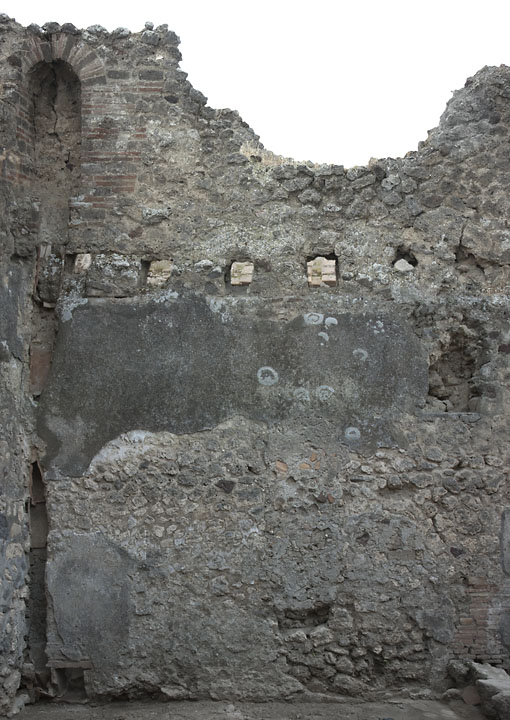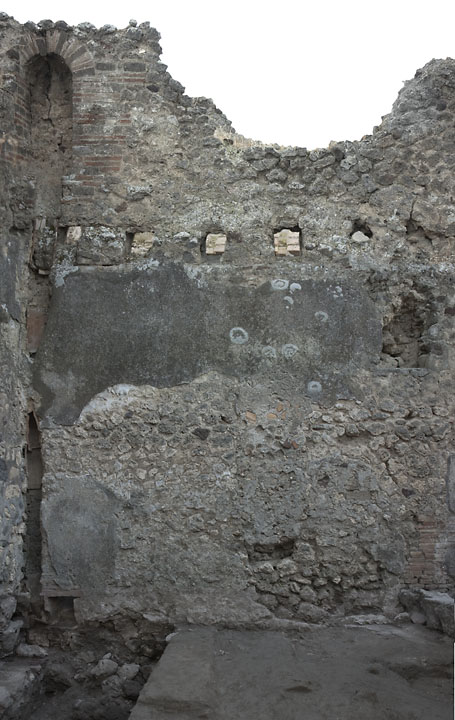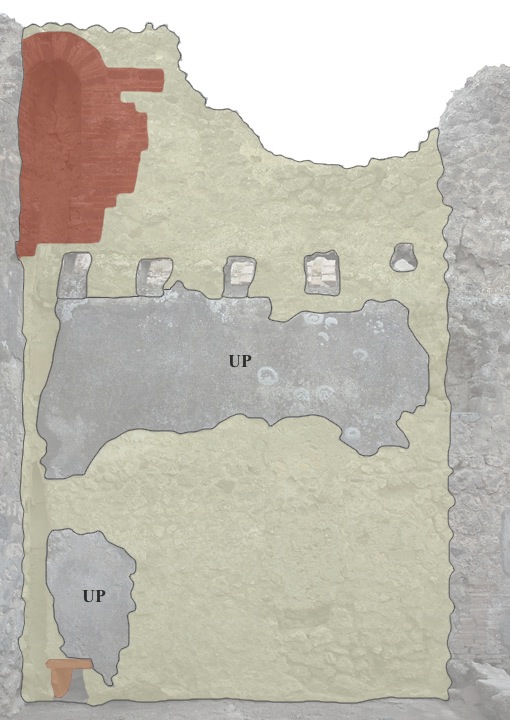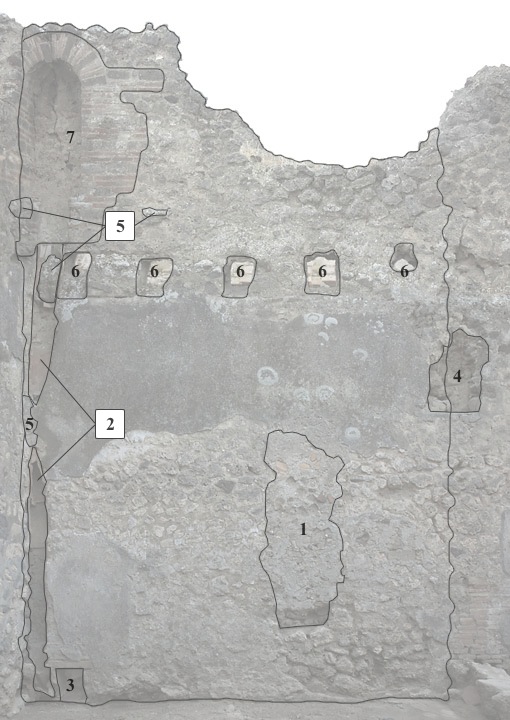South Wall
Description
Mats Holmlund
Ground floor
The wall is approximately 3.60 m wide, 3.15 m high in the east corner and 3.25 in the west. Most of the wall is constructed in opus incertum, but one small area towards the east corner and at the bottom of the wall, is constructed in opus testaceum.
There are quite a lot of features in the wall. First, there is a repaired breach, almost in the middle of the wall. It is located circa 2.05 m from the west corner and 0.40 m from the floor level, and it is 0.65 m wide and 1.70 m high. Below the breach there is a 0.40 m wide and 0.20 m high hole where a part of the repair is missing.
In the east corner there is a terracotta drain visible through a hole in the wall. The drain belongs to a latrine on the upper floor. The outer diameter of the terracotta pipes is circa 0.20 m, the inner diameter circa 0.18 m, and the height approximately 0.50 m. There are some pipes missing from the drain; first between 0.40 to 1.25 m from the floor level, and second between 2.95 and 3.35 m from the ground. Adjacent to the drain, at the floor level, there is another drainage from the toilet in room 3 of taberna V.1,31. This drainage consists of a 0.24 m wide and 0.25 m high rectangular opening in the wall. Both drains were connected to a cesspit or pozzo nero under the floor in the south east corner of the room.
Above the threshold of the doorway to room 1, circa 2.30 m from the floor level, there is a hole in the wall that is circa 0.45 m wide, 0.70 m high, and between 0.20 and 0.30 m deep. The hole marks the absent lintel of the doorway.
In the east corner circa 2.25 m from the floor level, there is some ash and lapilli stuck in the corner. The feature is circa 0.10 m wide and 0.25 m high.
There are two spolia visible in the wall. The first is a piece of mortar with plaster attached to it, located circa 2.70 m from the east corner and circa 1.80 m from the floor level. The second is a piece of cut tufa that is located circa 3.00 m from the east corner and 1.10 m from the ground. There are some terracotta pieces in the wall. All are located in the area of the repaired breach.
The mortar of the incertum part of the wall is yellowish grey and contains rather large grains (the diameter is between 0.002 and 0.01 m) of lava and limestone. Modern mortar has been applied along the edge of the second plaster area (see below) to keep it from falling down. There are also remnants of modern mortar on the west edge of the first area.
There are two areas of the wall where plaster remains. The first one is located low in the east corner. The area starts above the second drain and stretches from circa 0.30 to 1.00 m from the east corner, and from the floor level up until 1.35 m from the ground. The second area also starts at the east corner circa 1.80 m from the floor level and stretches across the wall to the lintel hole and then to the upper floor, approximately 3.35 to 3.40 m from the ground. The plaster is weathered and there are no decorations or colour pigments in either of the areas.
Upper floor
The upper floor wall is 3.60 m wide and 2.35 m high at its highest point. The main part of it is constructed in opus incertum. The exception is a niche for a toilet in the west corner that is constructed in opus listatum. The wall of the upper floor is circa 0.20 m thinner than the ground floor wall.
The niche of the latrine is approximately 0.49 m wide, 1.17 m high and 0.27 to 0.28 m deep. At the bottom of the niche, where the terracotta drain (the connection to the cesspit below the floor) starts, there is a small "ledge". The eastern part of the ledge is circa 0.10 m wide and the western part of it is circa 0.15 m wide. The upper part of the drain (between the ledge and the first terracotta pipe) seems to have been coated with some sort of water resistant plaster, part of which remains visible. Parts of the same water resistant plaster remain on the back wall and in the arched roof of the niche. The listatum construction consists of two rows of tiles, alternating with one row of cut tufa or limestone. The terracotta tiles vary in size from circa 0.05 to 0.25 m wide to 0.02 to 0.04 m high. The tufa and limestone bricks vary in size between 0.10 and 0.22 m wide and 0.06 and 0.10 m high.
There is a row of beam holes at the bottom of the second floor. The holes are between 0.21 and 0.24 m wide and circa 0.30 m high. The first hole is located circa 0.26 m from the east corner. The distance between the first and second hole is circa 0.42 m. This pattern is repeated for the other beam holes. The fifth beam hole is partly closed due to modern repairs.
There are four areas where ash and lapilli remains on the wall. The first is located on the east wall of the niche circa 0.30 m above the ledge. It is circa 0.20 m wide and 0.08 m high. The second is located in the drain, east of the first beam hole, where it is stuck in the drainpipe. It is circa 0.18 m wide and 0.45 m high. The third occurrence is located circa 0.30 m above the second beam hole and it measures circa 0.25 by 0.15 m. The last area is located 0.40 m straight above the third beam hole, and it is approximately 0.30 m wide and 0.35 m high.
There are remains of the upper floor flooring above between the third and fourth beam holes and the fourth and fifth beam holes. The first occurrence is circa 0.65 m wide, 0.30 m high and 0.20 m "deep" (at its deepest part). The second is circa 0.30 m wide, 0.30 m high and 0.05 m deep. The flooring was probably of lava pesta-style.
There is one spolia in the wall. A piece of coccio pesto floor is located circa 2.10 m from the east corner and approximately 0.70 m above the bottom of the row of beam holes.
The mortar seems to be the usual yellowish grey kind that contains grains of lava and limestone. The mortar seems also to be the same in both the incertum and the listatum part of the wall.
There are no remains of plaster in the wall.




